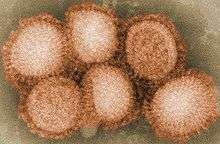Influenza A virus subtype H2N2
| Influenza (Flu) |
|---|
 |
| Types |
| Vaccines |
| Treatment |
| Pandemics |
| Outbreaks |
| See also |
H2N2 is a subtype of the influenza A virus. H2N2 has mutated into various strains including the Asian flu strain (now extinct in the wild), H3N2, and various strains found in birds. It is also suspected of causing a human pandemic in 1889.[1][2] The geographic spreading of the 1889 Russian flu have been studied and published.[3]
Russian flu
Some researchers have asserted that the 1889–1890 flu pandemic (also known as Russian flu) was caused by the influenzavirus A virus subtype H2N2. More recent research has suggested H3N8 as a more likely cause. It is the earliest flu pandemic for which detailed records are available.[4] "The 1889 pandemic, known as the Russian Flu, began in Russia and spread rapidly throughout Europe. It reached North America in December 1889 and spread to Latin America and Asia in February 1890. About 1 million people died in this pandemic."[5]
Asian flu
The category 2 Asian flu pandemic outbreak of influenza A virus originated in China in early 1956, and lasted until 1958. Some authors believe it originated from a mutation in wild ducks combining with a pre-existing human strain.[6] Other authors are less certain.[7] The virus was first identified in Guizhou.[8] It spread to Singapore in February 1957,[9] reached Hong Kong by April, and the US by June. The death toll in the US was about 69,800.[6] Estimates of worldwide deaths caused by this pandemic varies widely depending on source, ranging from one to four million, with WHO settling on "about two million".
Asian flu was of the H2N2 subtype (a notation that refers to the configuration of the hemagglutinin and neuraminidase proteins in the virus) of type A influenza, and an influenza vaccine was developed in 1957 to contain its outbreak.
The Asian flu strain later evolved via antigenic shift into H3N2, which caused a milder pandemic from 1968 to 1969.[10]
Both the H2N2 and H3N2 pandemic strains contained avian influenza virus RNA segments. "While the pandemic human influenza viruses of 1957 (H2N2) and 1968 (H3N2) clearly arose through reassortment between human and avian viruses, the influenza virus causing the 'Spanish flu' in 1918 appears to be entirely derived from an avian source (Belshe 2005)."[11]
Test kits

From October 2004 to February 2005, approximately 3,700 test kits of the 1957 H2N2 virus were accidentally spread around the world from the College of American Pathologists (CAP). CAP assists laboratories in accuracy by providing unidentified samples of viruses; private contractor Meridian Bioscience in Cincinnati, U.S., chose the 1957 strand instead of one of the less deadly avian influenza virus subtypes. "CAP spokesman Dr. Jared Schwartz said Meridian knew what the virus was but believed it was safe. In selecting it, the company had determined that the virus was classified as a biosafety level 2 (BSL-2) agent, which meant it could legally be used in the kits. [...] Before the problem came to light, the CDC had made a recommendation that the H2N2 virus be reclassified as a BSL-3 agent, Gerberding said. She promised to speed up the reclassification. The CDC determines the classifications in collaboration with the National Institutes of Health. In BSL-3 labs, agents are handled with equipment designed to prevent any airborne contamination and resulting respiratory exposure."[12] The 1957 H2N2 virus is considered deadly and the U.S. government called for the vials containing the strain to be destroyed.
"CDC officials reported on 21 April that 99% of the samples had already been destroyed. News reports on 25 April said the last samples outside the United States had been destroyed at the American University of Beirut in Lebanon, after they were found at the Beirut airport. Earlier reports said H2N2 samples were sent to 3,747 labs under CAP auspices and to about another 2,700 labs certified by other organizations. All but about 75 labs that received the CAP samples were in the United States."[13]
"In the United States, there is no government regulation over the 1957 flu strain. In fact, federal officials at the CDC do not even know how many U.S. laboratories keep this deadly strain in their viral libraries."[14]
Bibliography
- ↑ Sdstate.edu
- ↑ Pilva.com
- ↑ Alexis Madrigal (April 26, 2010). "1889 Pandemic Didn't Need Planes to Circle Globe in 4 Months". Wired Science. External link in
|publisher=(help) - ↑ "Encarta on influenza". Archived from the original on 2009-10-31.
- ↑ CIDRAP article Pandemic Influenza Last updated 16 Jun 2011
- 1 2 Greene Jeffrey. Moline, Karen. [2006] (2006) The Bird Flu Pandemic. ISBN 0-312-36056-8.
- ↑ Belshe Robert. [2005] (2005) The Origins of Pandemic Influenza. New England Journal of Medicine 353:2209-2211.
- ↑ Goldsmith, Connie. [2007] (2007) Influenza: The Next Pandemic? 21st century publishing. ISBN 0-7613-9457-5
- ↑ Germ Warfare, History Today
- ↑ Starling, Arthur. [2006] (2006) Plague, SARS, and the Story of Medicine in Hong Kong. HK University Press. ISBN 962-209-805-3
- ↑ Chapter Two : Avian Influenza by Timm C. Harder and Ortrud Werner from free on-line Book called Influenza Report 2006 which is a medical textbook that provides a comprehensive overview of epidemic and pandemic influenza.
- ↑ Roos, Robert (Apr 13, 2005). "Vendor thought H2N2 virus was safe, officials say". Center for Infectious Disease Research and Policy.
- ↑ Flu.org
- ↑ Globalist.com
Further reading
- Pandemic preparedness: lessons learnt from H2N2 and H9N2 candidate vaccines
- Interim CDC-NIH Recommendation for Raising the Biosafety Level for Laboratory Work Involving Noncontemporary Human Influenza Viruses
- New Scientist: Bird Flu
- Pandemic-causing 'Asian flu' accidentally released
- Persistence of Q strain of H2N2 influenza virus in avian species: antigenic, biological and genetic analysis of avian and human H2N2 viruses
External links
- Influenza Research Database Database of influenza sequences and related information.